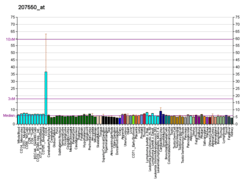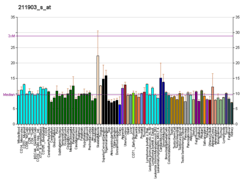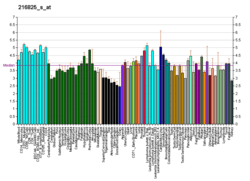Thrombopoietin receptor
The thrombopoietin receptor also known as the myeloproliferative leukemia protein or CD110 (Cluster of Differentiation 110) is a protein that in humans is encoded by the MPL (myeloproliferative leukemia virus) oncogene.[5]
Discovery
In 1990 an oncogene, v-mpl, was identified from the murine myeloproliferative leukemia virus that was capable of immortalizing bone marrow hematopoietic cells from different lineages. In 1992 the human homologue, named, c-mpl, was cloned. Sequence data revealed that c-mpl encoded a protein that was homologous with members of the hematopoietic receptor superfamily. Presence of anti-sense oligodeoxynucleotides of c-mpl inhibited megakaryocyte colony formation.
Function
The ligand for c-mpl, thrombopoietin, was cloned in 1994. Thrombopoietin was shown to be the major regulator of megakaryocytopoiesis and platelet formation.
The protein encoded by the c-mpl gene, CD110, is a 635 amino acid transmembrane domain, with two extracellular cytokine receptor domains and two intracellular cytokine receptor box motifs . TPO-R deficient mice were severely thrombocytopenic, emphasizing the important role of CD110 and thrombopoietin in megakaryocyte and platelet formation. Upon binding of thrombopoietin, CD110 is dimerized and the JAK family of non-receptor tyrosine kinases, as well as the STAT family, the MAPK family, the adaptor protein Shc and the receptors themselves become tyrosine phosphorylated.[5]
Interactions
Myeloproliferative leukemia virus oncogene has been shown to interact with:
Clinical relevance
Mutations in this gene have been shown to cause familial aplastic anemia.[9]
Mutations to this gene are also associated with myelofibrosis and essential thrombocythemia.[10] In essential thrombocythemia, mutations occur at position 505 or 515. In myelofibrosis, a mutation occurs at position 515 (W515 mutation). These mutations lead to the production of thrombopoietin receptors that are constitutively activated, or constantly turned on, which results in the overproduction of abnormal megakaryocytes.[11]
See also
References
- 1 2 3 GRCh38: Ensembl release 89: ENSG00000117400 - Ensembl, May 2017
- 1 2 3 GRCm38: Ensembl release 89: ENSMUSG00000006389 - Ensembl, May 2017
- ↑ "Human PubMed Reference:".
- ↑ "Mouse PubMed Reference:".
- 1 2 "Entrez Gene: MPL myeloproliferative leukemia virus oncogene".
- ↑ Meunier C, Bordereaux D, Porteu F, Gisselbrecht S, Chrétien S, Courtois G (Mar 2002). "Cloning and characterization of a family of proteins associated with Mpl". J. Biol. Chem. 277 (11): 9139–47. PMID 11784712. doi:10.1074/jbc.M105970200.
- ↑ Bellido M, Te Boekhorst PA (2012). "JAK2 Inhibition: Reviewing a New Therapeutical Option in Myeloproliferative Neoplasms.". Adv Hematol. 2012: 535709. PMC 3286888
 . PMID 22400031. doi:10.1155/2012/535709.
. PMID 22400031. doi:10.1155/2012/535709. - ↑ Nakaya Y, Shide K, Niwa T, Homan J, Sugahara S, Horio T, Kuramoto K, Kotera T, Shibayama H, Hori K, Naito H, Shimoda K (2011). "Efficacy of NS-018, a potent and selective JAK2/Src inhibitor, in primary cells and mouse models of myeloproliferative neoplasms.". Blood Cancer J. 1 (7): e29. PMC 3255248
 . PMID 22829185. doi:10.1038/bcj.2011.29.
. PMID 22829185. doi:10.1038/bcj.2011.29. - ↑ Walne AJ, Dokal A, Plagnol V, Beswick R, Kirwan M, de la Fuente J, Vulliamy T, Dokal I (December 2011). "Exome sequencing identifies MPL as a causative gene in familial aplastic anemia". Haematologica. 97 (4): 524–8. PMC 3347658
 . PMID 22180433. doi:10.3324/haematol.2011.052787.
. PMID 22180433. doi:10.3324/haematol.2011.052787. - ↑ Tefferi, A; Lasho, T L; Finke, C M; Knudson, R A; Ketterling, R; Hanson, C H; Maffioli, M; Caramazza, D; Passamonti, F; Pardanani, A (2014). "CALR vs JAK2 vs MPL-mutated or triple-negative myelofibrosis: clinical, cytogenetic and molecular comparisons". Leukemia. 28 (7): 1472–1477. ISSN 0887-6924. doi:10.1038/leu.2014.3.
- ↑ Tefferi, A (2010). "Novel mutations and their functional and clinical relevance in myeloproliferative neoplasms: JAK2, MPL, TET2, ASXL1, CBL, IDH and IKZF1". Leukemia. 24 (6): 1128–1138. ISSN 0887-6924. PMC 3035972
 . PMID 20428194. doi:10.1038/leu.2010.69.
. PMID 20428194. doi:10.1038/leu.2010.69.
Further reading
- Kato T, Matsumoto A, Ogami K, Tahara T, Morita H, Miyazaki H (1999). "Native thrombopoietin: structure and function.". Stem Cells. 16 (5): 322–8. PMID 9766811. doi:10.1002/stem.160322.
- Vigon I, Mornon JP, Cocault L, Mitjavila MT, Tambourin P, Gisselbrecht S, Souyri M (1992). "Molecular cloning and characterization of MPL, the human homolog of the v-mpl oncogene: identification of a member of the hematopoietic growth factor receptor superfamily.". Proc. Natl. Acad. Sci. U.S.A. 89 (12): 5640–4. PMC 49348
 . PMID 1608974. doi:10.1073/pnas.89.12.5640.
. PMID 1608974. doi:10.1073/pnas.89.12.5640. - Souyri M, Vigon I, Penciolelli JF, Heard JM, Tambourin P, Wendling F (1991). "A putative truncated cytokine receptor gene transduced by the myeloproliferative leukemia virus immortalizes hematopoietic progenitors.". Cell. 63 (6): 1137–47. PMID 2175677. doi:10.1016/0092-8674(90)90410-G.
- Le Coniat M, Souyri M, Vigon I, Wendling F, Tambourin P, Berger R (1989). "The human homolog of the myeloproliferative virus maps to chromosome band 1p34.". Hum. Genet. 83 (2): 194–6. PMID 2550356. doi:10.1007/BF00286717.
- Drachman JG, Griffin JD, Kaushansky K (1995). "The c-Mpl ligand (thrombopoietin) stimulates tyrosine phosphorylation of Jak2, Shc, and c-Mpl.". J. Biol. Chem. 270 (10): 4979–82. PMID 7534285. doi:10.1074/jbc.270.10.4979.
- Mignotte V, Vigon I, Boucher de Crèvecoeur E, Roméo PH, Lemarchandel V, Chrétien S (1994). "Structure and transcription of the human c-mpl gene (MPL).". Genomics. 20 (1): 5–12. PMID 8020956. doi:10.1006/geno.1994.1120.
- Mu SX, Xia M, Elliott G, Bogenberger J, Swift S, Bennett L, Lappinga DL, Hecht R, Lee R, Saris CJ (1996). "Megakaryocyte growth and development factor and interleukin-3 induce patterns of protein-tyrosine phosphorylation that correlate with dominant differentiation over proliferation of mpl-transfected 32D cells.". Blood. 86 (12): 4532–43. PMID 8541543.
- Deveaux S, Filipe A, Lemarchandel V, Ghysdael J, Roméo PH, Mignotte V (1996). "Analysis of the thrombopoietin receptor (MPL) promoter implicates GATA and Ets proteins in the coregulation of megakaryocyte-specific genes.". Blood. 87 (11): 4678–85. PMID 8639837.
- Drachman JG, Kaushansky K (1997). "Dissecting the thrombopoietin receptor: functional elements of the Mpl cytoplasmic domain.". Proc. Natl. Acad. Sci. U.S.A. 94 (6): 2350–5. PMC 20091
 . PMID 9122198. doi:10.1073/pnas.94.6.2350.
. PMID 9122198. doi:10.1073/pnas.94.6.2350. - Ihara K, Ishii E, Eguchi M, Takada H, Suminoe A, Good RA, Hara T (1999). "Identification of mutations in the c-mpl gene in congenital amegakaryocytic thrombocytopenia.". Proc. Natl. Acad. Sci. U.S.A. 96 (6): 3132–6. PMC 15907
 . PMID 10077649. doi:10.1073/pnas.96.6.3132.
. PMID 10077649. doi:10.1073/pnas.96.6.3132. - Drachman JG, Millett KM, Kaushansky K (1999). "Thrombopoietin signal transduction requires functional JAK2, not TYK2.". J. Biol. Chem. 274 (19): 13480–4. PMID 10224114. doi:10.1074/jbc.274.19.13480.
- Cargill M, Altshuler D, Ireland J, Sklar P, Ardlie K, Patil N, Shaw N, Lane CR, Lim EP, Kalyanaraman N, Nemesh J, Ziaugra L, Friedland L, Rolfe A, Warrington J, Lipshutz R, Daley GQ, Lander ES (1999). "Characterization of single-nucleotide polymorphisms in coding regions of human genes.". Nat. Genet. 22 (3): 231–8. PMID 10391209. doi:10.1038/10290.
- Okabe S, Tauchi T, Morita H, Ohashi H, Yoshimura A, Ohyashiki K (1999). "Thrombopoietin induces an SH2-containing protein, CIS1, which binds to Mpl: involvement of the ubiquitin proteosome pathway.". Exp. Hematol. 27 (10): 1542–7. PMID 10517496. doi:10.1016/S0301-472X(99)00094-6.
- Miyakawa Y, Drachman JG, Gallis B, Kaushansky A, Kaushansky K (2000). "A structure-function analysis of serine/threonine phosphorylation of the thrombopoietin receptor, c-Mpl.". J. Biol. Chem. 275 (41): 32214–9. PMID 10918061. doi:10.1074/jbc.M005080200.
- van den Oudenrijn S, Bruin M, Folman CC, Peters M, Faulkner LB, de Haas M, von dem Borne AE (2000). "Mutations in the thrombopoietin receptor, Mpl, in children with congenital amegakaryocytic thrombocytopenia.". Br. J. Haematol. 110 (2): 441–8. PMID 10971406. doi:10.1046/j.1365-2141.2000.02175.x.
- Wang Q, Miyakawa Y, Fox N, Kaushansky K (2000). "Interferon-alpha directly represses megakaryopoiesis by inhibiting thrombopoietin-induced signaling through induction of SOCS-1.". Blood. 96 (6): 2093–9. PMID 10979953.
- Miyakawa Y, Rojnuckarin P, Habib T, Kaushansky K (2001). "Thrombopoietin induces phosphoinositol 3-kinase activation through SHP2, Gab, and insulin receptor substrate proteins in BAF3 cells and primary murine megakaryocytes.". J. Biol. Chem. 276 (4): 2494–502. PMID 11054408. doi:10.1074/jbc.M002633200.
- Tonelli R, Scardovi AL, Pession A, Strippoli P, Bonsi L, Vitale L, Prete A, Locatelli F, Bagnara GP, Paolucci G (2000). "Compound heterozygosity for two different amino-acid substitution mutations in the thrombopoietin receptor (c-mpl gene) in congenital amegakaryocytic thrombocytopenia (CAMT).". Hum. Genet. 107 (3): 225–33. PMID 11071383. doi:10.1007/s004390000357.
- Ballmaier M, Germeshausen M, Schulze H, Cherkaoui K, Lang S, Gaudig A, Krukemeier S, Eilers M, Strauss G, Welte K (2001). "c-mpl mutations are the cause of congenital amegakaryocytic thrombocytopenia.". Blood. 97 (1): 139–46. PMID 11133753. doi:10.1182/blood.V97.1.139.
External links
- MPL protein, human at the US National Library of Medicine Medical Subject Headings (MeSH)
This article incorporates text from the United States National Library of Medicine, which is in the public domain.






